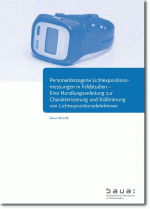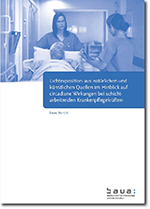Personal light exposure measurements in field studies - A guideline for characterisation and calibration of light exposure detectors
(in German)
Both natural light and artificial lighting affect the health and performance of people by their influence on circadian rhythms. In many field studies which deal with circadian influences, the personal light exposure is measured by light detectors. Detectors for personal measurement of light exposure available on the market are very different in terms of their metrological characteristics, and their limitations are often not taken into account. Several studies illustrate the importance of a prior characterisation and, if necessary, the calibration of the light exposure detectors, in order to achieve reliable outcomes.
This report represents the results of the characterisation and the calibration of 23 Actiwatch Spectrum detectors (Philips Respironics), which were carried out within the framework of the research project F 2355 "Determination of the actual light exposure from natural and artificial sources with regard to circadian effects in shiftworking employees". The detectors were characterized in terms of their linearity range, dark signal and their directional and spectral sensitivity. The results confirmed the need for calibration of Actiwatch Spectrum detectors, which was then carried out using three artificial light sources (a halogen, a fluorescent and a warm-white LED lamp) as well as the daylight.
Please download the complete report "Personal light exposure measurements in field studies - A guideline for characterisation and calibration of light exposure detectors" (in German only).
Bibliographic information
Title: Personenbezogene Lichtexpositionsmessungen in Feldstudien - Eine Handlungsanleitung zur Charakterisierung und Kalibrierung von Lichtexpositionsdetektoren.
1. edition. Dortmund: Bundesanstalt für Arbeitsschutz und Arbeitsmedizin, 2016. pages: 47, Project number: F 2355, paper, PDF file, DOI: 10.21934/baua:bericht20161220

